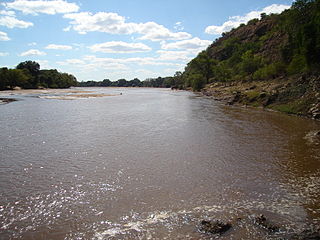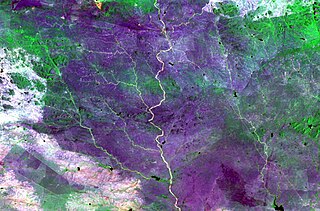Related Research Articles

The Kariba Dam is a double curvature concrete arch dam in the Kariba Gorge of the Zambezi river basin between Zambia and Zimbabwe. The dam stands 128 metres (420 ft) tall and 579 metres (1,900 ft) long. The dam forms Lake Kariba, which extends for 280 kilometres (170 mi) and holds 185 cubic kilometres (150,000,000 acre⋅ft) of water.
Kariba is a resort town in Mashonaland West province, Zimbabwe, located close to the Kariba Dam at the north-eastern end of Lake Kariba, near the Zambian border. According to the 2022 Population Census, the town had a population of 27,600.

Zimbabwe Parks and Wildlife Management Authority (Zimparks) is an agency of the Zimbabwe government managing national parks. Zimbabwe's game reserves are managed by the government. They were initially founded as a means of using unproductive land.
Bangala may refer to:
Bangala or Mɔnɔkɔ na bangála is a Bantu language spoken in the northeast corner of the Democratic Republic of the Congo, it is also spoken in parts of South Sudan and some speakers are still found in the extreme western part of Uganda. A sister language of Lingala, it is used as a lingua franca by people with different languages and rarely as a first language. In 1991 there were an estimated 3.5 million second-language speakers. It is spoken to the east and northeast of the area where Lingala is spoken. In Lingala, Bangala translates to "People of Mongala". This means people living along the Mongala River. Across Bas-Uele Province, Bangala speakers have to a great extent adopted Lingala.
Rutenga, is an important village in the province of Masvingo Province in Zimbabwe. It is the de facto capital of Mwenezi (District).

The Mzingwane River, formerly known Umzingwane River as or Umzingwani River is a major left-bank tributary of the Limpopo River in Zimbabwe. It rises near Fort Usher, Matobo District, south of Bulawayo and flows into the Limpopo River near Beitbridge, downstream of the mouth of the Shashe River and upstream of the mouth of the Bubye River.

The Shashe River is a major left-bank tributary of the Limpopo River in Zimbabwe. It rises northwest of Francistown, Botswana and flows into the Limpopo River where Botswana, Zimbabwe and South Africa meet. The confluence is at the site of the Greater Mapungubwe Transfrontier Conservation Area.

The Mwenezi River, originally known as the Nuanetsi River, is a major tributary of the Limpopo River. The Mwenezi River starts up in south central Zimbabwe and flows south-east along what is known as the Mwenezi River Valley that bisects the district into two sectors. The river is found in both Zimbabwe and Mozambique. In Zimbabwe it has been known as the Nuanetsi or Nuanetzi River in the past, a name it retains in Mozambique.

The Thuli River, former name Tuli River, is a major tributary of the Shashe River in Zimbabwe. It rises near Matopo Mission, Matobo District, and flows into the Shashe River near Tuli village.

WAFLEX is a spreadsheet-based model. It can be used to analyse upstream-downstream interactions, dam management options and water allocation and development options.

The Mtshabezi River is a tributary of the Thuli River in southern Zimbabwe. Mtshabezi river its scource is up from Matopos Hills, an area of granite kopjes and wooded valleys commencing some 35 kilometres south of Bulawayo, southern Zimbabwe. It supplys the Mtshabezi Dam which has become the 6th dam to supply is the second largest city in Zimbabwe, Bulawayo is the largest city in the country's Matabeleland region. The city's population is disputed; the 2022 census listed it at 665,940,[4] while the Bulawayo City Council claimed it to be about 1.2 million.
Thuli–Moswa Dam is the name for a proposed reservoir on the Thuli River, south of Gwanda, Zimbabwe with a capacity of 419 million cubic metres.

Thuli–Manyange (Elliot) Dam is proposed a reservoir on the Thuli River, south of Gwanda, Zimbabwe with a capacity of 33 million cubic metres. It is designed to be co-operated with Thuli–Moswa Dam

Oakley Block Dam is a proposed reservoir on the Mzingwane River, south of West Nicholson, Zimbabwe with a capacity of 41 million cubic metres.

The Bubye River, also known as Bubi River, is a tributary of the Limpopo River in Beitbridge District and Gwanda District, Zimbabwe. It rises about 40 kilometres (25 mi) to the northeast of West Nicholson in Matabeleland South, from where it flows southeast before joining the Limpopo about 25 kilometres (16 mi) west of the border with Mozambique. Its course forms part of the border between Mberengwa and Mwenezi districts.

The Mutirikwe River is a river in southeastern Zimbabwe. It is a tributary of the Runde River and its major tributaries include Pokoteke River.
Manjirenji Dam, formerly known as Lake McDougal, lies in south eastern Zimbabwe, east of Masvingo. It was built to provide irrigation water to the farming estates on the lowveld to the southwest, around the town of Chiredzi, where the main crop has been sugar cane.

Mutange Dam, across Mutange River, is a manmade earth fill embarkment dam located in Chisina Village, 30 km east of Gokwe and 35 km northwest of Empress Mine, in the Midlands Province of Zimbabwe. Mutange Dam is 42 km by road from Gokwe and 49 km from Empress, 117 km from Kadoma and 146 km from Kwekwe via Empress. It is owned and operated by the Ministry of Water Resources and Development.
References
- 1 2 "Bangala Dam". Zimbabwe National Water Authority. Archived from the original on 21 April 2013. Retrieved 13 January 2010.